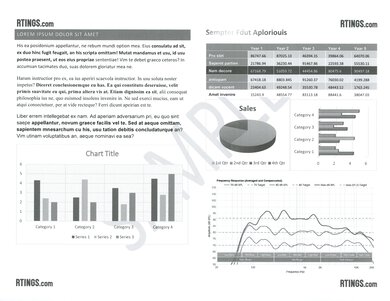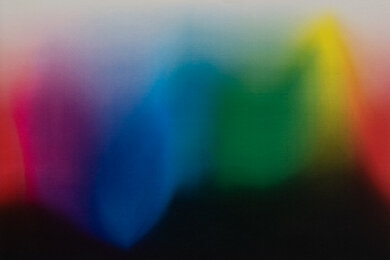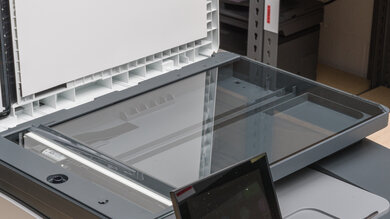
HP, also known as Hewlett-Packard, is a home electronics brand producing many computer-related products, including printers. Its diverse printer lineup includes models for your home or office and even portable printers with a built-in rechargeable battery. While its selection can be overwhelming, it's separated into several different lineups. Each lineup has various pros and cons that align with their specific usages, and they come at several price points, so you can find the best HP printer for home use or to meet your office needs. HP has had several controversies over the years, including one involving a software update that prevents the use of third-party cartridges when subscribed to HP's ink replenishment service.
Updates
- 12/17/2024HP Color LaserJet Pro MFP 3301fdw reviewed
- 11/22/2024HP ENVY 6155e reviewed
- 11/21/2024HP ENVY 6555e reviewed
- 10/23/2024HP OfficeJet Pro 9730e reviewed
- 07/26/2024HP OfficeJet 200 reviewed
Quick Look





Best HP Printer
 Document Quality9.5Color Quality5.3Scanner8.2Speed8.5Black-Only Printing Cost0.040 US$/printColor Printing Cost0.187 US$/printEstimated Black Page Yield1,719 printsEstimated Color Page Yield1,297 prints
Document Quality9.5Color Quality5.3Scanner8.2Speed8.5Black-Only Printing Cost0.040 US$/printColor Printing Cost0.187 US$/printEstimated Black Page Yield1,719 printsEstimated Color Page Yield1,297 printsThe best HP printer we've tested is the HP Color LaserJet Pro MFP 3301fdw. This all-in-one color laser printer is the go-to for small or home offices. It produces high-quality documents that look professional, and it sports tons of features, like an ADF-equipped scanner with automatic duplex scanning and wide connectivity options. It's a little slow to warm up and get a single page out, but it's very fast once it gets going, pushing up to 27 black or color pages per minute. The printer feels very well-built overall, though it's quite large, so it'll take up a lot of desk space.
Maintenance is pretty easy. The regular toner cartridges are good for around 1,700 black and 1,300 color prints, and you can get XL cartridges that'll last longer. Though on the expensive side, remember that the cartridges also contain the drum, which means you won't have to replace the drum separately. The downside with this design is that you'll have to discard the entire cartridge if the drum breaks, wasting usable toner. Our main gripes with this printer concern the scanner: scans sometimes come out crooked when using the automatic feeder, and the scanner's image processing is too aggressive in removing artifacts, resulting in the loss of some fine details.
Best Upper Mid-Range HP Printer
 Document Quality8.5Color Quality6.5Scanner8.1Speed8.4Black-Only Printing Cost0.028 US$/printColor Printing Cost0.104 US$/printEstimated Black Page Yield1,482 printsEstimated Color Page Yield779 prints
Document Quality8.5Color Quality6.5Scanner8.1Speed8.4Black-Only Printing Cost0.028 US$/printColor Printing Cost0.104 US$/printEstimated Black Page Yield1,482 printsEstimated Color Page Yield779 printsIf you'd prefer an inkjet model, check out the HP OfficeJet Pro 9135e, a feature-rich inkjet all-in-one designed for small and home offices. It has a sturdy build, a large, touch-sensitive display, and wide connectivity options, including Ethernet. There's an ADF-equipped scanner with automatic duplex scanning, although it's on the slower side, as it only processes up to six pages per minute. The scanner's lid hinges are extendable, making it easier to close the lid over thicker items like textbooks and magazines when using the flatbed. Printing-wise, this model produces sharp documents. Its print speed isn't as impressive as the HP Color LaserJet Pro MFP M283fdw, but it's still good at 23 black and 15 color pages per minute.
While the photo printing quality is better than that of laser printers, it still isn't great because its limited color range and low print resolution result in a significant loss of fine details. Its cost-per-print is outstanding, though; the ink cartridges yield a large number of prints and are relatively cheap. It also comes with three months of free ink when you set up the printer with HP+, HP's 'smart' platform, which includes Instant Ink and their ink subscription service. However, subscribing to the service will block you from using third-party cartridges in the future, even if you cancel your subscription. Also, the printer needs a continuous internet connection to function, should you choose to set up the printer with HP+, even when using a wired USB connection. See HP's FAQ page to learn more.
Best Mid-Range HP Printer
 Document Quality9.5Color Quality6.5Scanner7.4Speed6.9Black-Only Printing Cost0.077 US$/printColor Printing Cost0.128 US$/printEstimated Black Page Yield246 printsEstimated Color Page Yield274 prints
Document Quality9.5Color Quality6.5Scanner7.4Speed6.9Black-Only Printing Cost0.077 US$/printColor Printing Cost0.128 US$/printEstimated Black Page Yield246 printsEstimated Color Page Yield274 printsAt an even lower price range, we have the HP OfficeJet Pro 8025e, one of the best HP printers for home use we've tested. While this model has been discontinued, it's still readily available through major retailers and online marketplaces. Depending on the region in which you live or the retailer, you may find it under another model number, like the 8022e or 8035e. As with all HP printers with an 'e' suffix, this is an HP+ model and includes a six-month subscription to HP's ink replenishment service. The same restrictions apply, meaning if you set up the printer using HP+ and subscribe to the Instant Ink service, you can't use third-party cartridges in the future, and the printer requires a constant internet connection to function. See the FAQ page for HP+ on HP's website to learn more.
It's a sturdily built printer with a user-friendly touch-sensitive display and plenty of connectivity options, including USB, Wi-Fi, and Ethernet. It produces exceptionally sharp black and color documents; it's just a little slow, as it only prints up to 10 black or six color pages per minute. For photo printing, printed pictures look detailed but muted because the printer has a narrow color range. Unfortunately, the ink cartridges are only good for about 240 black and 270 color prints, meaning you'll have to replace them regularly. The cost-per-print is still low, though, as the cartridges are inexpensive. The scanner produces good quality scans; however, it's rather slow, as it only scans three pages per minute through the automatic feeder and doesn't support duplex scanning.
Best Budget HP Printer
 Document Quality8.0Color Quality6.7Scanner6.6Speed7.3Black-Only Printing Cost0.191 US$/printColor Printing Cost0.181 US$/printEstimated Black Page Yield110 printsEstimated Color Page Yield232 prints
Document Quality8.0Color Quality6.7Scanner6.6Speed7.3Black-Only Printing Cost0.191 US$/printColor Printing Cost0.181 US$/printEstimated Black Page Yield110 printsEstimated Color Page Yield232 printsIf you need something that can get the job done for those occasional projects, consider the HP OfficeJet 8015e. This printer's MSRP is higher than we normally recommend for a budget printer; however, it often goes on sale for around $100 USD, making it a great value. It looks almost identical to our mid-range pick, the HP OfficeJet Pro 8025e, but it has a few compromises compared to its bigger sibling, including a smaller monochrome display, slightly worse print and scan quality, and the lack of Ethernet connectivity. Its printing speed is faster than the 8025e, pushing out 15 black or six color pages per minute.
The biggest drawbacks of this model are its page yield and recurring costs. Its black and color cartridges yield only about 110 black and 232 color prints, leading to frequent replacements. Like the 8025e, it also comes with six months of included ink if you set up the printer with HP+ and subscribe to the Instant Ink service, but again, this will block you from using third-party cartridges, which are typically less expensive.
Best Portable HP Printer
 Document Quality8.5Color Quality6.2Scanner6.7Speed3.1Black-Only Printing Cost0.114 US$/printColor Printing Cost0.195 US$/printEstimated Black Page Yield167 printsEstimated Color Page Yield123 prints
Document Quality8.5Color Quality6.2Scanner6.7Speed3.1Black-Only Printing Cost0.114 US$/printColor Printing Cost0.195 US$/printEstimated Black Page Yield167 printsEstimated Color Page Yield123 printsFor on-the-go printing, we recommend the HP OfficeJet 250, a compact model with a built-in rechargeable battery. It's a great option if you travel a lot for work or run an outdoor kiosk and need to print receipts. The battery is good for about 225 prints and takes around two hours to charge fully. It produces sharp documents but is a little slow, as it only prints three black or six color pages per minute. Despite its compact size, you still get an ADF scanner that produces high-quality scans. It also has an optical character recognition (OCR) feature that lets you save scans as PDFs for quick keyword searches.
The biggest downside with this printer is its page yield, as it can only print 100 to 150 pages before the ink runs out, meaning you might need to carry a few extra cartridges. The cost-per-print isn't too bad because the cartridges are relatively cheap, although color printing can get expensive if you print a lot. On the upside, you can get XL cartridges that'll last longer, and it also accepts third-party ink, which might be cheaper.
Compared To Other Brands
- Diverse lineup.
HP offers many different models focusing on various needs, like photo printing or office use.
- Quick printing speeds.
For the most part, both the LaserJet Enterprise/Pro and OfficeJet Pro lineups have pretty quick print speeds for all kinds of documents, while the ENVY lineup can print photos fairly quickly (although its document printing isn't as fast).
- Confusing model names.HP tends to use different model numbers for the same product to indicate the region and retailer where the printer is sold, which can be very confusing for the average user.
- Mediocre print quality on low-end models.Budget HP printers tend to have worse print quality than other brands like Brother and Canon.
- Questionable practices.
HP has some questionable practices. It often sells HP+ models that come with three or six months of free ink through their ink subscription service and an extended warranty if you agree to set up the printer with HP+; however, this will block you from using third-party cartridges, even if you cancel your ink subscription later on. Printers will also require a constant internet connection, even if you are printing via USB.
HP vs Brother
HP and Brother are both major printer manufacturers. While Brother is known for laser printers, it also has a small lineup of inkjets. Brother printers typically have better print quality, especially on lower-end models. However, HP has a wider range of printers, including portable printers and laser printers with a refillable toner tank, similar to supertank inkjet models. See our recommendations for the best Brother printers.
HP vs Epson
There are many differences between Epson and HP. HP produces a wide range of printers, including laser, inkjet, and portable models, while Epson focuses almost exclusively on inkjet desktop models. HP printers typically have better print quality for document printing, but Epson printers usually perform better when it comes to photo printing. Epson produces a lot of supertank models, which have significantly better page yield than most HP printers. Check out our recommendations for the best Epson printers.
HP vs Canon
HP and Canon are very similar, as both companies make a wide range of printers. Canon focuses more on photo printing, while HP focuses more on general-purpose office and personal printers. Canon laser models usually perform better and cost less. However, those with a large print load might want to consider HP, as it makes laser models with a refillable toner tank, similar to supertank inkjet printers. To learn more about Canon, check out our recommendations for the best Canon printers.
HP produces a diverse range of printers, each for different uses. For example, its photo printing lineup ENVY is comparable to Canon's PIXMA lineup, while its LaserJet Pro and LaserJet Enterprise lineups are more similar to Brother's current offering of office printers. As a whole, HP's printers share few similar characteristics between lineups. However, thanks to their variety, they come in many different price ranges, so you can find something at a price point that suits your budget and usage.
Lineup
HP offers several different printer lineups to suit your specific needs, including:
- DeskJet: Entry-level, compact inkjet printers for home use. They tend to have somewhat limited scanning features.
- ENVY: Inkjet printers meant for printing photos. They focus on rich, detailed photo printing quality and more precise color accuracy.
- LaserJet Pro: Laser printers for small/home office use. Some are monochrome, and others use color toners. Unlike the LaserJet Enterprise line, they usually support wireless connectivity.
- LaserJet Enterprise: Laser printers designed for small businesses that need to print off a significant amount of pages. They tend to be print-only and have a very quick print speed. They're marketed as more secure because they use wired connections for printing.
- OfficeJet: Inkjet printers that are better suited for home/small office use. They're usually well-rounded printers capable of printing in black as well as color.
- Smart Tank: Supertank inkjet printers. These printers tend to have outstandingly high page yields.
Recent Updates
Apr 23, 2025:
Minor text changes for conciseness and clarity. No change in recommendations.
Jan 23, 2025:
Replaced the HP Color LaserJet Pro MFP M283fdw with the HP Color LaserJet Pro MFP 3301fdw because the M283fdw is discontinued and hard to find.
Oct 29, 2024:
We've verified that our recommendations are available and represent the best that HP has to offer. We've also made edits for clarity throughout the recommendation and updated our description of HP+ and Instant Ink to better explain their significance to users.
Aug 08, 2024: We've done a major overhaul of this article, introducing a new format and new performance usages.
May 06, 2024: We made minor text changes to improve clarity. No change in recommendations.
Conclusion
HP is a well-known brand that has many different printers at varying prices. Its printer's build quality and performance can vary significantly, depending on the lineup. While its Smart Tank and LaserJet Pro models tend to have very high yields, many of its budget or cheap options have poor yields; there can even be a noticeable difference between models sharing the same cartridge. That said, HP's printers can suit most budgets and printing needs while offering a fairly well-rounded performance.
Comments
Best HP Printers: Main Discussion
What do you think of our picks? Let us know below.
Looking for a personalized buying recommendation from the RTINGS.com experts? Insiders have direct access to buying advice on our insider forum.
- 21010
The model number is X515EA-212.V15TB
- 32120
Yes, it will make 30/60 material duplicated. But I suppose even with the duplications, it might seem “clearer” to the average person versus a screen with less duplications, but more motion blur.
Personally I would want the ability to choose 60hz for 60fps games, 120hz when interpolating, and flicker-free for movies, since those have baked-in motion-blur anyway.
But I guess most TV manufacturers find it easier to go with a one size fits all approach. They probably believe 120hz to be a good enough tradeoff between flicker and clarity.
- 32120
If the TV is interpolating to 120fps, then flickering the backlight at 120hz will provide the clearest possible image. If the backlight stayed at 240hz for example, then fast motion would have a shaky double-image effect. Or at 480hz you’d get a quadruple effect. At even higher frequencies, or on flicker-free screens, it will instead look more like excessive motion blur. Ideally, your backlight’s flicker rate should always match the framerate.
Since the main purpose of interpolation is to increase motion resolution, I imagine that’s Samsung’s reasoning.
It is dumb that they force it though. They ought to let users set whatever flicker frequency they want.
Edited 5 years ago: spelling errors








![HP OfficeJet Pro 8025e [8022e, 8028e, 8035e] Document Quality Picture](https://i.rtings.com/assets/products/mbWhPV3m/hp-officejet-pro-8025e-8022e-8028e-8035e/black-white-small.jpg?format=auto)
![HP OfficeJet Pro 8025e [8022e, 8028e, 8035e] Color Quality Picture](https://i.rtings.com/assets/products/1UFPyOO3/hp-officejet-pro-8025e-8022e-8028e-8035e/color-gamut-small.jpg?format=auto)
![HP OfficeJet Pro 8025e [8022e, 8028e, 8035e] Scanner Picture](https://i.rtings.com/assets/products/0Jfx2ULW/hp-officejet-pro-8025e-8022e-8028e-8035e/scanner-small.jpg?format=auto)
![HP OfficeJet Pro 8025e [8022e, 8028e, 8035e] Speed Picture](https://i.rtings.com/assets/products/QcaBxXSy/hp-officejet-pro-8025e-8022e-8028e-8035e/printing-speed_thumb_small.jpg?format=auto)































